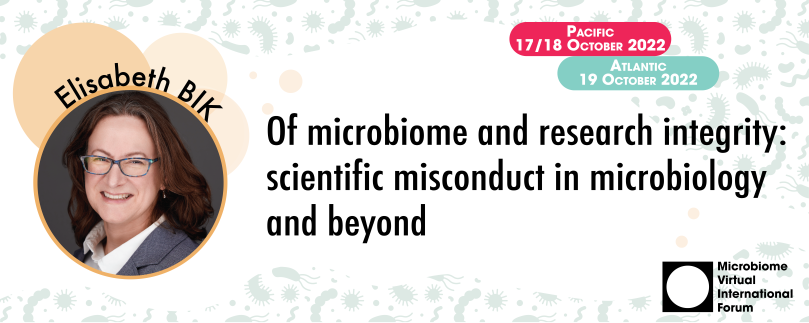ABSTRACT
Science builds upon science. Even after peer-review and publication, science papers could still contain images or other data of concern. If not addressed post-publication, papers containing incorrect or even falsified data could lead to wasted time and money spent by other researchers trying to reproduce those results. Several high-profile science misconduct cases have been described, but many more cases remain undetected. Elisabeth Bik is an image forensics detective with a microbiology background, who left her paid job in industry to search for and report biomedical articles that contain errors or data of concern. She has done a systematic scan of 20,000 papers in 40 journals and found that about 4% of these contained inappropriately duplicated images. In her talk she will discuss her career shift from working in academia and industry on microbiome research to her present work on inappropriately duplicated images and other examples of research misconduct. In addition, she will show how to report scientific papers of concern, and how journals and institutions handle such allegations.
SHORT BIO
Elisabeth Bik, PhD is a Dutch-American microbiologist who has worked for 15 years at Stanford University and 2 years in industry. Since 2019, she is a science integrity volunteer and consultant who scans the biomedical literature for images or other data of concern and has reported over 6,000 scientific papers. Her work has resulted in over 800 retracted and almost 1,000 corrected papers
Selected talks
Contamination detection in genomic data: more is not enough
The decreasing cost of sequencing and concomitant augmentation of publicly available genomes have created an acute need for automated software to assess genomic contamination. During the last 6 years, 18 programs have been published, each with its own strengths and weaknesses. Deciding which tools to use becomes more and more difficult without an understanding of the underlying algorithms. We review these programs, benchmarking six of them, and present their main operating principles. This article is intended to guide researchers in the selection of appropriate tools for specific applications. Finally, we present future challenges in the developing field of contamination detection.
Luc Cornet
University of Liege, Belgium
In-depth insights into cervicovaginal microbial communities and hrHPV infections using high-resolution microbiome profiling
The cervicovaginal microbiome (CVM) correlates with women's cervical health, and variations in its composition are associated with high-risk human papillomavirus (hrHPV) infection outcomes. Cervicovaginal microbes have been grouped into five community state types (CSTs) based on microbial community composition and abundance. However, studying the impact of CSTs in health and disease is challenging because the current sequencing technologies have limited confident discrimination between closely related and yet functionally different bacterial species. Circular probe-based RNA sequencing (ciRNAseq) achieves high-resolution microbiome profiling and therefore provides in-depth and unambiguous knowledge about the composition of the CVM. Based on ciRNAseq profiling of a large cohort of cervical smears (n = 541), we here define subgroups of CSTs I, III, and IV based on intra-CST differences with respect to abundances of Lactobacillus acidophilus (CSTs I-A vs. I-B and CSTs III-A vs. III-B), Lactobacillus iners (CSTs I-A vs. I-B and CSTs III-A vs. III-B), and Megasphaera genomosp type 1 (CSTs IV-A vs. IV-B). Our results further support the existence of subgroups of CST IV-C that are dominant for non-Lactobacillus species and have intermediate microbial diversity. We also show that CST V is associated with uninfected conditions, and CST IV-A associates with hrHPV-induced cervical disease. In conclusion, we characterized new subdivisions of cervicovaginal CSTs, which may further advance our understanding of women's cervical health and hrHPV-related progression to disease.
Mariano A. Molina
Radboud University Medical Center
Exploring the human lung virome from shotgun metagenomic studies
Introduction: The lung virome is an understudied portion of the human microbiome that is gaining increasing attention in medical research due to its public health significance. It is estimated that up to 95% of the lung virome remains uncharacterised. Here, we aim to catalogue the virome associated with the human respiratory tract by reanalysing publicly available data using a newly-developed pipEline for Viral assEmbly and chaRactEriSaTion (EVEREST). Methods: Lung virome studies (n=85) utilising shotgun metagenomics and lung-attributed samples were gathered from public databases. Following manual curation (n=44), bioproject data was inputted into EVEREST (https://agudeloromero.github.io/EVEREST/), resulting in viral discovery and taxonomic classification of known and unknown viruses. Complete and high-quality contigs were further assessed for genomic characterisation. Results: From a singular bioproject (PRJEB32062), 182 viral contigs were captured and 14 were classified as complete/high-quality. Those contigs lengths ranged between 12-387 kilobases. Focusing on three of the complete/high-quality contigs, we discovered two novel prophages (Caudovirales), and a new bacteriophage (Siphoviridae). Additionally, putative protein coding sequence regions were scanned, which ranged between 50-67 proteins. Annotation analysis showed phage-associated proteins, including proteases, DNA binding proteins and tail sheath and tube proteins, among others. Conclusion: We identified known and novel viruses utilising publicly available lung metagenome studies. Knowledge gained in the pulmonary virome will facilitate additional understanding of the virus-host microbiome interaction. We are in the process of expanding the EVEREST pipeline to other uncharacterised human niches. Grant Support: Pawsey Supercomputing Research Centre, and Australian Government Research Training Program Scholarship.
Talya Conradie
Murdoch University, Telethon Kids Institute
Open-access Paper Highlights:
Gut microbiota of the threatened takahē: biogeographic patterns and conservation implications
The Aotearoa New Zealand takahē (Porphyrio hochstetteri), once thought to be extinct, is a nationally threatened flightless rail under intensive conservation management. While there has been previous research into disease-related microbes in takahē, little is known about the microbes present in the gastrointestinal tract. Given the importance of gut-associated microbes to herbivore nutrition and immunity, knowledge of these communities is likely to be of considerable conservation value. Here we examined the gut microbiotas of 57 takahē at eight separate locations across Aotearoa New Zealand. Faecal samples, taken as a proxy for the hindgut bacterial community, were subjected to 16S rRNA gene amplicon sequencing using Illumina MiSeq. Phylogenetic analysis of > 2200 amplicon sequence variants (ASVs) revealed nine main bacterial phyla (Acidobacteriota, Actinobacteriota, Bacteroidota, Campilobacterota, Firmicutes, Fusobacteriota, Planctomycetota, Proteobacteria, and Verrucomicrobiota) that accounted for the majority of sequence reads. Location was a significant effect (p value < 0.001, 9999 permutations) that accounted for 32% of the observed microbiota variation. One ASV, classified as Lactobacillus aviarius, was present in all samples at an average relative abundance of 17% (SD = 23.20). There was strong evidence (p = 0.002) for a difference in the abundance of the genus Lactobacillus between locations. A common commensal bacterium previously described in takahē, Campylobacter spp., was also detected in most faecal samples. Location plays a pivotal role in the observed variation among takahē gut bacterial communities and is potentially due to factors such as supplemental feeding and medical treatment experienced by birds housed in captivity at one of the eight sampled sites. These data present a first glimpse of the previously unexplored takahē gut microbiota and provide a baseline for future microbiological studies and conservation efforts.
Link to OA paper: https://animalmicrobiome.biomedcentral.com/articles/10.1186/s42523-021-00158-5#Abs1
Annie West
University of Auckland
Surgical Treatment for Colorectal Cancer Partially Restores Gut Microbiome and Metabolome Traits
Accumulating evidence indicates that the gut microbiome and metabolites are associated with colorectal cancer (CRC). However, the influence of surgery for CRC treatment on the gut microbiome and metabolites and how it relates to CRC risk in postoperative CRC patients remain partially understood. Here, we collected 170 fecal samples from 85 CRC patients pre- and approximately 1 year postsurgery and performed shotgun metagenomic sequencing and capillary electrophoresis-time of flight mass spectrometry (CE-TOFMS)-based metabolomics analyses to characterize alterations between pre- and postsurgery. We determined that the relative abundance of 114 species was altered postsurgery (P < 0.005). CRC-associated species, such as Fusobacterium nucleatum, were decreased postsurgery. On the other hand, Clostridium scindens, carcinogenesis-associated deoxycholate (DCA)-producing species, and its biotransformed genes (bai operon) were increased postsurgery. The concentration of 60 fecal metabolites was also altered postsurgery (P < 0.005). Two bile acids, cholate and DCA, were increased postsurgery. We developed methods to estimate postoperative CRC risk based on the gut microbiome and metabolomic compositions using a random forest machine-learning algorithm that classifies large adenoma or early-stage CRC and healthy controls from publicly available data sets. We applied methods to preoperative samples and then compared the estimated CRC risk between the two groups according to the presence of large adenoma or tumors 5 years postsurgery (P < 0.05). Overall, our results show that the gut microbiome and metabolites dynamically change from pre- to postsurgery. In postoperative CRC patients, potential CRC risk derived from gut microbiome and metabolites still remains, which indicates the importance of follow-up assessments.
Link to OA paper: https://journals.asm.org/doi/10.1128/msystems.00018-22
Hirotsugu Shiroma
School of Life science and Technology, Tokyo Institute of Technology, Tokyo, Japan

